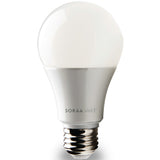How Poor Heat Management Compromises LED Lifetime
Posted by Dave on for ProLampSales
One of the benefits of LED light bulbs sometimes touted by the media and by manufacturers alike is "no heat."
If the heat being referred to is radiant, meaning it heats objects but not the air in between, the claim is accurate. Put your hand a few inches away from a standard 60 watt incandescent bulb and you will feel heat. That is radiant heat from a hot tungsten filament, the source of the light. Now, do the same with a 60 watt equivalent LED bulb. No heat.
LEDs are solid state devices that can be designed to produce visible, near-infrared or near ultraviolet light. For visible light, the IR and UV wavelengths can be virtually eliminated, with the result that the spectral output of LEDs for general lighting does not contain radiated infrared heat. This is, indeed, a benefit for most lighting applications.
The focus of this post is not radiated heat from the front of the light bulb, but conducted heat from inside it. LEDs produce light at a semiconductor junction where photons are produced when current is applied. Heat is produced at the junction. This heat needs to be removed or early junction failure will result.
LEDs are designed to transfer heat from the junction by conduction to the iconic cooling fins visible on most LED bulbs. These fins act as a heat sink. Touch the fins when the bulb is producing light and there will be little doubt about their significance.
Dissipating solid state generated heat puts new demands on both manufacturers and consumers.
Manufacturers cannot ignore the requirement of a well-designed heat sink. High junction temperatures nullify any advantages of LED over other light sources because of the likelihood of degraded light output and reduced bulb life.
Driven by the phase-out of common incandescent and halogen bulbs, the commoditization of LEDs may be pushing manufacturers to skimp on good thermal management designs both for aesthetic and cost reasons. At higher wattages in particular, any compromise on heat sink quality will almost certainly reduce the life of the bulb.
Unfortunately, the consumer has no easy way to evaluate a heat sink other than by looking at the bulb or holding it and then guessing. Without any solid information to act on, the best approach may be either to buy only from major brands, or to physically compare the heat sink design of the bulb they want to purchase to that of one of the well known brands. There is no guarantee bulbs from the biggest manufactures are the best, but barring other ways to evaluate this crucial component of an LED bulb, it seems the prudent approach.
Thermal management of LED light sources does not end with the manufacturer. Consumers need to know that light output and rated life will be adversely affected if they are placed inside enclosed or poorly ventilated fixtures where it will be difficult to dissipate heat. Air flow around the heat sink removes the heat build-up by convection, allowing the heat sink to continue pulling heat from the solid state components.
Using LED bulbs in recessed downlights and completely enclosed fixtures increases the burden on the heat sink compared to a table lamp or a contemporary track lighting system.
There are no easy answers for consumers when it comes to evaluating heat sink design or ensuring adequate air flow in certain applications. Being aware of the importance of thermal management will at least give context to the claim of "no heat" as a benefit of LED lighting.
- Posted in LED
Featured Products (View All)
0 Comments




